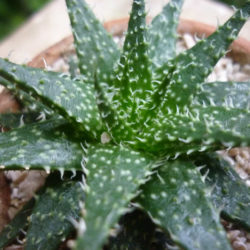Scientific Name
Aloe 'Pepe'
Synonym(s)
Aloe descoingsii × haworthioides
Scientific Classification
Family: Asphodelaceae
Subfamily: Asphodeloideae
Genus: Aloe
Origin
This succulent is a hybrid created by John Bleck by crossing Aloe descoingsii and Aloe haworthioides, species native to Madagascar.
Description
Aloe 'Pepe' is a dwarf succulent that forms rosettes of fleshy, triangular, dark green leaves with soft white teeth along the margins and white spots growing into additional teeth on both surfaces. The rosettes grow to 2 inches (5 cm) in diameter, producing numerous offsets and forming a small, dome-shaped clump.
The tiny tubular flowers are yellowish- to pinkish-orange and appear on up to 1 foot (30 cm) long stalk in summer.

Hardiness
USDA hardiness zone 10a to 11b: from 30 °F (−1.1 °C) to 50 °F (+10 °C).
How to Grow and Care
Aloes is a very forgiving plant. However, as with all succulents, they must never be allowed to sit in stagnant water and should be carefully monitored for signs of overwatering. Water generously in the summer and nearly cease watering in the winter. Do not let water stand in the rosettes. Prefers warmer temperatures of 70 to 80 ºF (21 to 27º C) but will survive down to 40 ºF (4.5 ºC).
Aloes are not particularly fast-growing and will only rarely need repotting. Repot plants in the spring that are tipping over their pots or have ceased growing. Use a fast-draining potting mix with one-third of sand or pebbles. When repotting a larger plant, dividing the root ball carefully is possible. Some Aloes will produce offsets that can be potted independently.
See more at How to Grow and Care for Aloe.
Links
- Back to genus Aloe
- Succupedia: Browse succulents by Scientific Name, Common Name, Genus, Family, USDA Hardiness Zone, Origin, or cacti by Genus
Photo Gallery
Click on a photo to see a larger version.



